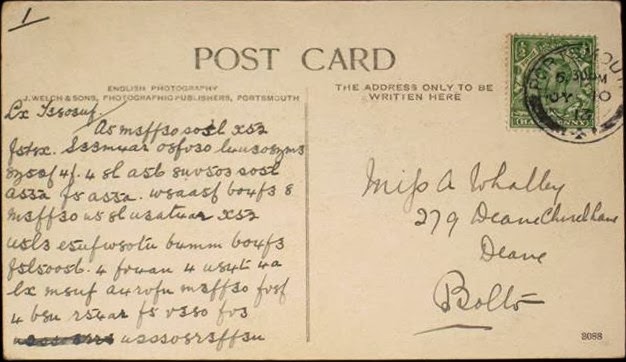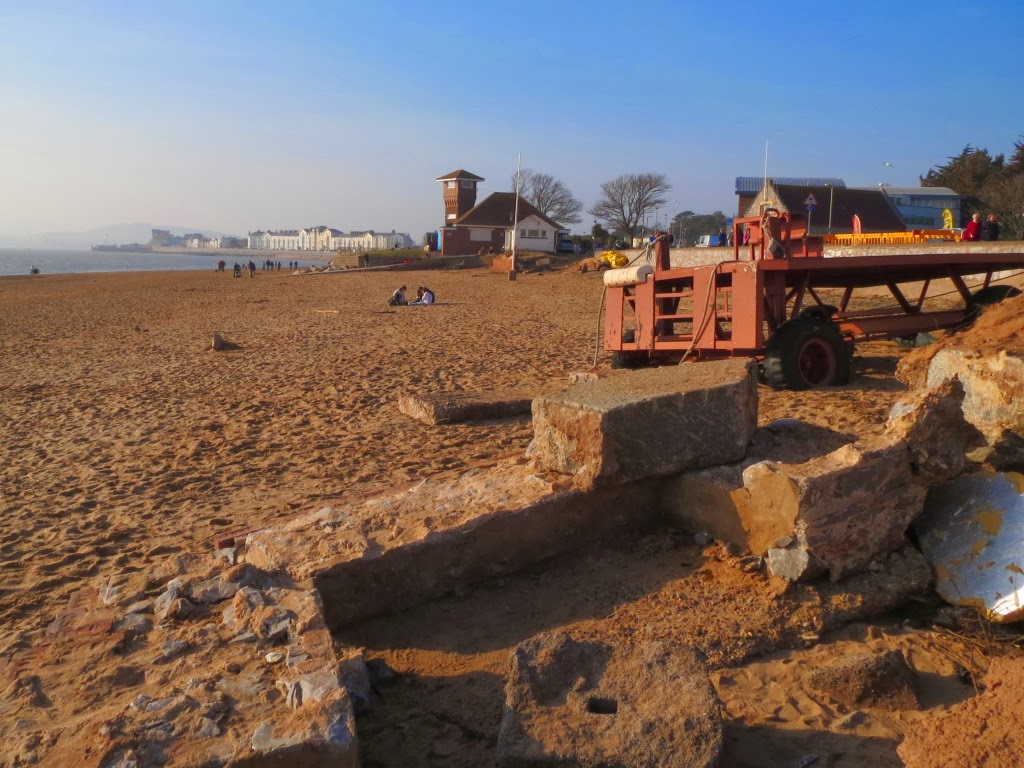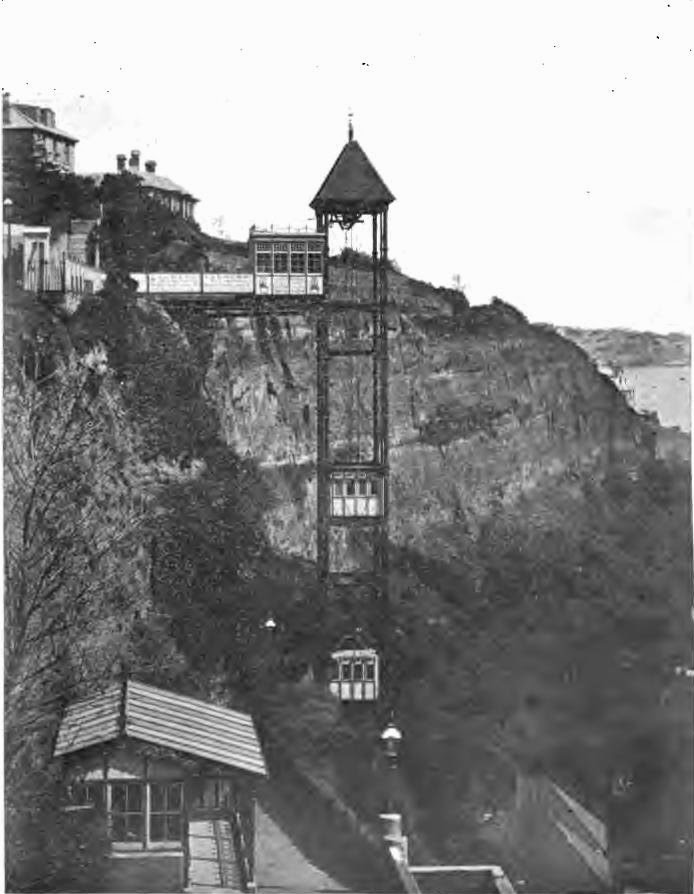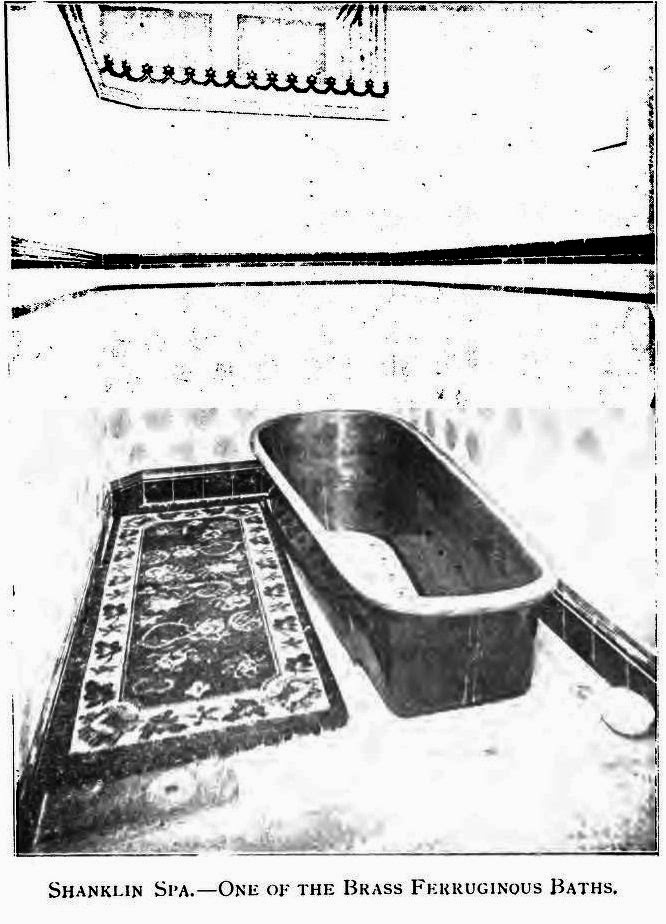In March 2011 - see Salutation Inn - I wrote about an obscure novel I'd discovered through reviews: Richard Gray's Salutation Inn (pub. Michael Joseph, 1941). Gray, I found, was a pseudonym of the artist Jasper Salwey (c.1883-1956) and one review said that the setting, the fictional Ilham, is "a place which can easily be identified as Topsham".
Yesterday, a pleasant follow-up: Ed Williams-Hawkes, owner of the real-world Salutation Inn, kindly lent me his copy of the novel he'd found at some expense on eBay (the book is very scarce). I just finished reading it, and there is no doubt about the identification.
The novel is somewhere between psychological thriller and rural Gothic, beginning when a man called Inigo Orton – but for reasons yet unknown calling himself Mr Crawley - drifts in to the seedy Salutation Inn in the sleepy riverside town of Ilham. It’s occupied by various unhappy souls: the alcoholic landlord Pomper, his disillusioned wife Mrs Pomper, their dissatisfied teenage son Arch(ibald), and the help Jenny. Orton, evidently driven by some guilt or anxiety, drinks to the point of nausea, then somehow manages to sleep with Jenny. So starts his stay of six increasingly doom-laden weeks in the Salutation Inn.
Orton spends his days wandering the marshes near Ilham, and the evenings drinking. He hears Schubert being played upstairs, and, investigating, meets another inhabitant, the half-mad Mrs Benson, who finds in him a substitute for her late son Richard. On the basis of this, he dines with Audrey, Benson’s widow and the last of what passes for aristocracy in Ilham. He also makes the acquaintance of Blake, a young artist visiting the area to paint nature scenes.
Over the weeks, Orton’s stay begins to attract attention. Arch Pomper, who has aspirations to becoming a detective (the other alternatives are becoming a butcher's apprentice or spending a lifetime tarring boats), has suspicions about Orton’s motives. Orton also attracts the hostile attention of Jim Cory, a bus conductor jealous of Orton’s relationship with Jenny; he thinks he recognises Orton.
Motives begin to be laid bare when Blake, Jenny and Orton coincidentally visit Hinibury, the regional town, on the same day. Blake wants to marry Jenny and take here away from the place (he gives her a contact address in Bosham); she refuses. Orton later meets her, and they have sex in a wooded quarry outside town; he asks her an unspecified favour, and the two return to Ilham separately.
On Orton’s return, he finds wild celebrations going on in the Salutation; uncertain of the meaning, he hides until they finish, and creeps back in. He finds the Pompers majorly drunk along with another local, Cheriton, who tells him that a brewery traveller, Nokes, has been visiting, telling stories about a wanted murderer. Frightened, Orton hides in the Salutation Cellar but becomes lost when his candle goes out, until he finds his way out through a secret passageway that leads to Mrs Benson’s room. She’s unsurprised – now she even calls him by the name Richard - and asks him to convey a message that she wants Audrey Benson to visit her.
The next day, Orton spends the morning on the marshes, contemplating leaving Ilham, but something draws him back, and he visits Audrey to tell her the message. His visit is interrupted by a call from the doctor, saying that Mrs Benson has overdosed and is dying, but has asked for him. Meanwhile, Joe Cory and Arch Pomper have got to comparing notes, and they’re on to Orton: that he’s wanted for a murder in London where a young woman was found unconscious and a man was thrown out of a window.
On Orton’s return to the Salutation, Arch confronts him by name. Orton knocks him unconscious, and hides him in the yard before taking a drink in another pub, then frantically seeking out Jenny at a planned rendezvous. The plan was that she conceal his haversack, and the two leave town together. She hides him in Mrs Benson’s decrepit and unoccupied house. Orton cowers there as Nokes returns to the Salutation and the full story of Orton’s crime is revealed, while Jenny makes plans to smuggle him out of town.
Orton, meanwhile, has been asleep. He wakes, disorientated in the strange house, and climbs the stairs to an attic room, where he’s terrified by the apparition of a man with a “ghastly physiognomy” and “distorted head”. Thus fazed, he falls down the stairs; his flight through the air to the stone passage below is the final sentence of the book.
It’s by no means as bad a book as I’d imagined from the reviews. The idea of a doomed man escaping to the very place where his doom will be played out is quite neat, and well-plotted. But its chief weakness is that the author puts the viewpoint in the mind of the lead character, yet censors from the reader what that character knows (and undoubtedly thinks) about the events prior to the story. This comes across as cheating. That aside, the tightening screw on Orton is well-paced.
I wonder if it had at least some inspiration from Stella Gibbons'Cold Comfort Farm. Although not comedy, Salutation Inn has a great deal in common: the rural setting, nearby aristocratic home, and its house of troubled characters (Mrs Pomper recalls the careworn Judith Starkadder, and Mrs Benson - the trauma-haunted old lady upstairs - even more strongly resembles Aunt Ada Doom).
Naturally, a deal of the interest to someone living in Topsham is the local setting. Ilham isn't explicitly stated to be in Devon, but Orton is said to have been eating bread and cheese on Exmoor the day before arriving at the Salutation. There are a few deliberate distortions of location, such as the nearby main town, “Hinibury”, being twelve miles away, but there’s no doubt of it being Topsham (especially as, on page 279, “Ilham” is called “Exham” - presumably a fossil of an earlier draft).
Chapter 2 of Salutation Inn begins with a fairly vicious caricature of Topsham in its period of decline in the middle of the 20th century.
Beyond this, there are many detailed correspondences, starting with the Salutation Inn itself. The internal layout of the Salutation isn’t portrayed entirely clearly, but many features tally with its historical appearance: the separate front bar and Smoke Room, the yard with its pump and gateway to an orchard, and the Assembly Room (the Coffee Room in the novel) overlooking the street.
There are a number of recognisable nearby locations: Ship Street, adjacent to the Salutation, matches Exe Street; and Ferry Lane, the next street, with limekilns at the river end, matches Follett Road. “South House” at “The Point” is clearly Riversmeet House, at the southern tip of Topsham. It’s described (p 62) as:
See the earlier post Salutation Inn for contemporary reviews of the novel.
- Ray
Yesterday, a pleasant follow-up: Ed Williams-Hawkes, owner of the real-world Salutation Inn, kindly lent me his copy of the novel he'd found at some expense on eBay (the book is very scarce). I just finished reading it, and there is no doubt about the identification.
The novel is somewhere between psychological thriller and rural Gothic, beginning when a man called Inigo Orton – but for reasons yet unknown calling himself Mr Crawley - drifts in to the seedy Salutation Inn in the sleepy riverside town of Ilham. It’s occupied by various unhappy souls: the alcoholic landlord Pomper, his disillusioned wife Mrs Pomper, their dissatisfied teenage son Arch(ibald), and the help Jenny. Orton, evidently driven by some guilt or anxiety, drinks to the point of nausea, then somehow manages to sleep with Jenny. So starts his stay of six increasingly doom-laden weeks in the Salutation Inn.
Orton spends his days wandering the marshes near Ilham, and the evenings drinking. He hears Schubert being played upstairs, and, investigating, meets another inhabitant, the half-mad Mrs Benson, who finds in him a substitute for her late son Richard. On the basis of this, he dines with Audrey, Benson’s widow and the last of what passes for aristocracy in Ilham. He also makes the acquaintance of Blake, a young artist visiting the area to paint nature scenes.
Over the weeks, Orton’s stay begins to attract attention. Arch Pomper, who has aspirations to becoming a detective (the other alternatives are becoming a butcher's apprentice or spending a lifetime tarring boats), has suspicions about Orton’s motives. Orton also attracts the hostile attention of Jim Cory, a bus conductor jealous of Orton’s relationship with Jenny; he thinks he recognises Orton.
Motives begin to be laid bare when Blake, Jenny and Orton coincidentally visit Hinibury, the regional town, on the same day. Blake wants to marry Jenny and take here away from the place (he gives her a contact address in Bosham); she refuses. Orton later meets her, and they have sex in a wooded quarry outside town; he asks her an unspecified favour, and the two return to Ilham separately.
On Orton’s return, he finds wild celebrations going on in the Salutation; uncertain of the meaning, he hides until they finish, and creeps back in. He finds the Pompers majorly drunk along with another local, Cheriton, who tells him that a brewery traveller, Nokes, has been visiting, telling stories about a wanted murderer. Frightened, Orton hides in the Salutation Cellar but becomes lost when his candle goes out, until he finds his way out through a secret passageway that leads to Mrs Benson’s room. She’s unsurprised – now she even calls him by the name Richard - and asks him to convey a message that she wants Audrey Benson to visit her.
The next day, Orton spends the morning on the marshes, contemplating leaving Ilham, but something draws him back, and he visits Audrey to tell her the message. His visit is interrupted by a call from the doctor, saying that Mrs Benson has overdosed and is dying, but has asked for him. Meanwhile, Joe Cory and Arch Pomper have got to comparing notes, and they’re on to Orton: that he’s wanted for a murder in London where a young woman was found unconscious and a man was thrown out of a window.
On Orton’s return to the Salutation, Arch confronts him by name. Orton knocks him unconscious, and hides him in the yard before taking a drink in another pub, then frantically seeking out Jenny at a planned rendezvous. The plan was that she conceal his haversack, and the two leave town together. She hides him in Mrs Benson’s decrepit and unoccupied house. Orton cowers there as Nokes returns to the Salutation and the full story of Orton’s crime is revealed, while Jenny makes plans to smuggle him out of town.
Orton, meanwhile, has been asleep. He wakes, disorientated in the strange house, and climbs the stairs to an attic room, where he’s terrified by the apparition of a man with a “ghastly physiognomy” and “distorted head”. Thus fazed, he falls down the stairs; his flight through the air to the stone passage below is the final sentence of the book.
It’s by no means as bad a book as I’d imagined from the reviews. The idea of a doomed man escaping to the very place where his doom will be played out is quite neat, and well-plotted. But its chief weakness is that the author puts the viewpoint in the mind of the lead character, yet censors from the reader what that character knows (and undoubtedly thinks) about the events prior to the story. This comes across as cheating. That aside, the tightening screw on Orton is well-paced.
I wonder if it had at least some inspiration from Stella Gibbons'Cold Comfort Farm. Although not comedy, Salutation Inn has a great deal in common: the rural setting, nearby aristocratic home, and its house of troubled characters (Mrs Pomper recalls the careworn Judith Starkadder, and Mrs Benson - the trauma-haunted old lady upstairs - even more strongly resembles Aunt Ada Doom).
Naturally, a deal of the interest to someone living in Topsham is the local setting. Ilham isn't explicitly stated to be in Devon, but Orton is said to have been eating bread and cheese on Exmoor the day before arriving at the Salutation. There are a few deliberate distortions of location, such as the nearby main town, “Hinibury”, being twelve miles away, but there’s no doubt of it being Topsham (especially as, on page 279, “Ilham” is called “Exham” - presumably a fossil of an earlier draft).
Chapter 2 of Salutation Inn begins with a fairly vicious caricature of Topsham in its period of decline in the middle of the 20th century.
A local history remarks of Ilham, ‘Ilham is a small town situated on a tidal estuary some twelves miles south of Hinibury. It is noted for having been, in Tudor times, a place of seafaring activity and ship-building, the ruins of the old yards and slip-ways being still traceable. It is the site of an Early British Settlement. Founded by the Dutch, many of the houses built by them still stand as evidence of past prosperity. An occasional ketch bringing limestone still furnishes its half-ruined kilns. The growing of watercress, which flourishes as early as March of the year, occupies a number of its inhabitants. Population at last census, eleven hundred. Nearest station, Hinibury, eleven miles.’
When not engaged in the drinking of cider, its few remaining fishermen may bestir themselves to run down river for salmon or even cross the bar to the bay and net for mackerel, but this is rare.
Thus Illham is fairly distinguished as ‘having been,’ verily a lost place stimulated into a semblance of life by the sheer necessities of somehow discovering a means of living in the place of birth. Still the residence of the dwindling remains of a few once affluent families, the sale of whose treasures—furniture, paintings, books, china—would have served to provide for its population for a generation, or to have have restored it to a place of practical value. But such things do not happen.
On exploration of its streets and alleyways, Ilham would have been found to provide at least a dozen licensed houses. Some were but dens where a counter, a bench, and half a dozen barrels were the complete equipment. Among these places of resort, ‘The Salutation’ ranked as a comparatively grand house where the practice of drinking ‘on tick’ was not encouraged. It was the meeting place of all those members of the drinking fraternity who believed they held social important in the town, and who would hardly deign to be seen elsewhere.
 |
| Fore Street and Salutation - scan of undated photo lent by W Maxwell, Salutation proprietor in 2004 |
 |
| Feb 20th, 2014 |
Beyond this, there are many detailed correspondences, starting with the Salutation Inn itself. The internal layout of the Salutation isn’t portrayed entirely clearly, but many features tally with its historical appearance: the separate front bar and Smoke Room, the yard with its pump and gateway to an orchard, and the Assembly Room (the Coffee Room in the novel) overlooking the street.
There are a number of recognisable nearby locations: Ship Street, adjacent to the Salutation, matches Exe Street; and Ferry Lane, the next street, with limekilns at the river end, matches Follett Road. “South House” at “The Point” is clearly Riversmeet House, at the southern tip of Topsham. It’s described (p 62) as:
… the acme of gentility, the very symbol of wealth, the last stronghold of that prosperity and price which this little seaport had once boasted.The Strand also features, in similarly jaundiced description:
Orton’s trysting place with Mrs Benson was at the foot of The Strand, that little street beside the river that divided the old Dutch houses from their corresponding gardens and complementary gazebos. Here Ilham’s last gesture of aristocracy was supported on the pedestal of money, and but for that even these so little and so pathetic comforts, these vanities, these little castles of pride would be but the four walls of emptiness, the haunted domiciles of ghosts.Overall, then, the portrayal of the town is pretty hostile. And yet, when the protagonist is in a better mood, the description of Ilham turns affectionate:
And these morning wanders above and about the old quaysides amidst quaint and time-worn things, fused the senses into a compelling comprehension of the vitializing magic of springtime. To stroll down between the little houses and to come upon the little beaches and landings leading to the water’s edge, to step casually into the old ferry-boat and be rowed across the width of the river seemed each morning so simple yet even so novel as to leave him silent with a desire to absorb the fierceness of living. It enlivened him afresh each morning to land on the far bank and wander upwards over the muddy shoals, on over the sodden tide-washed grass and then to turn and view the wharves and houses, a pattern of colour full in the risen sunlight, their features reflected in the lazy water. It was but a little fairy town hanging in the air.Ed drew my attention to the inclusion of the artist, Blake, as a character. It seems very likely that the author, Salwey, had a younger version of himself in mind. He would have been 58 or so at the time of publication of Salutation Inn, but had visited Topsham well before that. The above drawing, Autumn Morning—Topsham, appears in his 1921 book The Art of Drawing in Lead Pencil (Internet Archive ID cu31924074492475). Not much else is immediately findable about him; basic credentials and a short bibliography appear posthumously in the Directory of British Architects, 1834-1914: Vol. 2 (L-Z), 2001 (see page 532).
See the earlier post Salutation Inn for contemporary reviews of the novel.
- Ray






















































































.jpg)
















